
|
Vintage Television Sets and Colour Television Sets from the Dawn of Television until Now
Echard Etzold's Site |
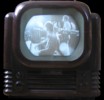
|
Vintage television:
Documentation: Bush TV22
1950
Click photo for enlargement!
|
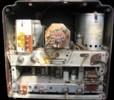
|
One of the most famous and unusual tv sets was made in U.K. by Bush. It is the
TV22. In comparison to today's tv sets this set operates with the historic
british television norm of 405 lines per frame and positive video amplidute modulation. The audio signal
was also broadcast in amplidute modulation and not in FM like in the U.S. and continental European postwar
tv standards. The BBC one programme in British 405 line standard was broadcasted until 1985 before it was switched off.
Since 1985 all British tv programmes were broadcasted in 625 PAL television standard.
This set here was preadjusted for the Birningham transmitter (Channel 4, VHF with video on 61.75 MHz and audio on 58.25 MHz).
|
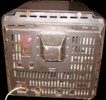
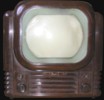
The case of the set is made of bakelite, the design was dominated by round curves and the
round screen of the 9 inch picture tube. This set became a worldwide famous example of British
industrial art and design. In 1950, this set was sold for £36 and £42. More informations are available on the web:
1, 2.
|
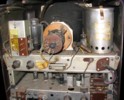
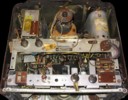
Since my childhood I was familiar with German tv sets and their schematics, and since the last years with the upcoming of
the internet with American television technology. But when I got this Bush TV22 in May, 2006, I took a short view on it and put it away.
This set looks completely different to what I have seen before. The schematics are very strange. I was wondering about these few parts in it
in comparison to our German tv technology. Later I learned from Darius, an friend of mine here in Germany who is familiar with this tv standard,
that this strange look depends on the British television standard. With this positive video modulation there are not so many circuits necessary
to generate a proper picture on the screen. From time to time, people came to see my collection. Usually their eyes wandered over the tv sets and got stuck on the Bush TV22: "Oh, what a nice set. Can you switch it on?""Oh no", I replied, "it is not in operating mode", and they were disappointed. Meanwhile I was irritated and bored of the visitors comments. When they got stuck with their eyes on this set I pre-empted them: "No, no, no, this set is not in operating mode."
|
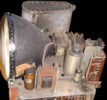
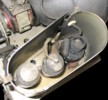
In January 2007, after a long time of talkings and research about the specials of the British standard, I felt confidence enough for restoring the
set. The picture tube was tested. There was no emission. Absolutely zero! I gave power to the filaments and heated the picture tube for 24 hours.
But again there was no emission. This valve was dead.
The chassis looks really bad, the tar insulation of the line output transformer was dried and cracky. Darius said, this is not problematic. It will work fine when the set is in operating mode. First I checked the capacitors in the vertical unit for shorts. There are no which could be measured with a simple Ohm meter. The main electrolytic
capacitor was formatted with a low D.C. current, in steps of 5 V, starting with 5 V up to 200 V. No significant increase of current was
regsitered. After that I did a first test and fired up the set. Some whistling indicated that the line oscillator worked. On the screen, a small dim horizontal line appeared which was only
visible in absolutely darkness. Some hum out of the loudspeaker
indicated that the audio output should work.
The brightness of the picture tube was not enough for displaying a full raster. I gave a short pulse for reactivating the electron gun from a picture tube reactivator. There was for a split of a second a blue corona around the cathode inside the picture tube. After that I measured 0.2 mA current. This was enough for getting a visible raster in case of working condition. But still my aim was to get spare MW 22-16.
|


I have checked the schematics and found that the most critical wax capacitors are on the main deck. They are the coupling capacitors and the line and frame time base capacitors. Only these capacitors were replaced: on the main deck and the side plate C24, C26, C27, C29, C30, C31 (both for proper brightness), C52, C56, C57, C58, C59, C60, C61, C62, C63. So, in my opinion, in the TV22, 15 capacitors are at least really critical. C74 is critical of course. But if C74 has leakage current, the fuse will melt. So you can decide to keep C74 until the fuse acts.
After that the set was switched on again.
A blue glow inside the PL 38 seems to be suspect. I asked in Paul Stenning's forum for that, but I got the answer: PL 38s can glow blue like that with no problem.
I got a very dim
raster. Darius borrowed me a self-made analogue standard converter for the London Alexandra palace transmitter (Channel 1). I got no signal. This set was made for the Birningham area and not for London. But with some fine tuning it was later possible to display a
signal. As one can see there was no synchronisation. The line frequency was below tv standard. I could not step up it. The value of a resistor which was in series with the horizontal hold was increased. I soldered a 100K resistor parallel to it. Now I got the correct line hold frequency. But still there was no synchronisation.
|
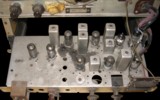
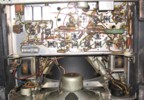
While measuring the grid and anode voltages at the pentode of the ECL 80, I found that the anode voltage at pin 6 was only 2 V. It should be appr. 140 V. This misfunctioning depended on a leaky capacitor C55 which was soldered below the main deck plate, so I forgot to replace it. After that I got a first picture with full synchronisation. Features like AGC or vertical and horizontal blanking were omitted in the Bush TV22. But as far as I can see, they are not necessary here.
|

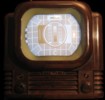
While testing the set, suddenly there was a failure. From one moment to another I got a very quiet line whistle, a short moment only a vertical line and then no high voltage, no picture. At first I thought the line output transformer was burned. Of course it looked very bad. It looks like some tar melted. For safety reasons I inserted a resistor between screen grid of the PL38 and booster voltage like Darius has recommended it.
Darius gave an instruction how to measure the resonance frequency of the line output transformer to find out whether it is dead or not. He found 38 KHz with 1 Vpp on his line output transformer. I found 110 KHz with 0.3 Vpp and 230 KHz also with 0.3 Vpp. In the expected range around 38 KHz there was nothing. This was suspect. Darius' next hint was to test C34 (see schematics of Paul Stenning). This is the small flat mica capacitor at the line output transformer (T2 over d and e).
There was a short in C34 , the 470 pF capacitor parallel to the line output coil which I had replaced before with a 630 voltage d.c. type.
Some more informations about this failure might be interesting for those which have recapped the main deck. I have replaced all capacitors with 630 V d.c. types. This was too low. Darius gave me the hint that the flat capacitors are not waxies. They are covered with wax, but inside they consist of mica. I replaced C34 with the original one. The "new" capacitor had indeed a short.
After replacing the capacitor I measured the resonance frequency again. Now I found a peak at 40 KHz with appr. 2 Vpp. This might be OK. Now it was the time to switch on the set: Now I got high voltage and a raster again.
Meanwhile I got a spare picture tube from the Netherlands with 0.8 mA emission. I replaced the picture tube.
Now I got an excellent picture and I enjoy British television standard with 405 lines and thought,
it was a pity that the BBC had switched off transmissions in 405 line.
But perhaps there is a chance to bring the Alexandra palace
transmitter back to life. See The British Heritage Television Project
and the web site of 405 Alive.
The set is currently working with Darryl Hock's
Low cost standard converter with RF Modulator, see left photo.
Here are screenshots which report the progress in resoring the set:
1, 2, 3, 4. Beside the technical details, it is also interesting to read about the impact of television in the 1950's. Stuart, a kind chap from Scotland, sent me the following note:
All I can say is that in Scotland, unlike England, very few people could afford these sets when they were being sold. Most Scottish people, especially children, would have a friend in the area whose parents were wealthy enough to own a T.V. and on certain days when something special was on TV all the local children would gather in the friend with the TVs house to watch that programme. Adults would be invited by friends with TV to see special programmes, inc. football, tennis etc., etc.
I do remember that TV shops used to sell large magnifying glasses which were attached to the T.V. by straps thereby making the picture bigger. In the early to mid 1950's my friends and I would gather round the window of the local T.V shop at night, when the shop was closed, to watch the television which was in the window. We would eat candy and drink soft drinks whilst standing watching "the Telly" as we called it. We couldnt hear the sound but it was exciting just to see the pictures.These were the days!
He wrote about the Birningham transmitter:
I cannot say for certain, but can say that the Independant Television Co., which introduced advertising and started transmitting in the 1950s had a Transmitter in an are midway between Glasgow and Edinburgh, Scotlands 2 main cities. The programmes did not run for long during the day, most often starting at lunchtime 12.30.am, with a lunchtime easy listening,easy viewing programme. This ended at 2.00pm and transmisson started again at 4.30/5.00pm, continuing until approx.11.30 / 12.00am at night. The programme transmission always ended with a short( 5 minutes) Christian religious message from a minister or priest and "God save the Queen" anthem. A Christian message would not be tolerared nowadays in this mad Politically Correct(p.c.) world but it has to be said that many old people enjoyed a few minutes of religious texts or stories before going to bed.
|
Schematics
Please ask Paul Stenning.
Valves
6 x EF91, 2 x EB91, 2 x ECL80, PL33, PL83, PL38, PZ30, EY51, MW22-16
Photos: © Eckhard Etzold, 2006, 2007.
Thanks to Darius Mottaghian-Milani for his support and recommendations.
Links:
BUSH TV22 Mk.1
TV22 Restoration - A great thread in Paul Stenning's forum
 Back Back
![[English text]](Images/flag_en.jpg)
![[Zurück]](Images/arr-supr.jpg)
Stand: 15. Februar 2007,
|